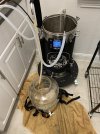Thanks!!!!!! Of course that brings up more questions.
1. I don’t have a problem checking mash temps, but how easy is to then calibrate?
2. No way I’ll be allowed to do a pulley or anything like that in the drop ceiling. Or anything that would put weight on anything except a shelf (which there is not space for, nor the studs). I’m pretty strong, but still don’t like the idea and potential mess. but if I understand, you pull it up and let it sit? so it’s not so drippy when I move to my bin to take to the compost?
3. Great tip- thanks! I haven’t used rice hulls in a long time and wouldn’t have them on hand so I can order some with grain.
4. I’ve gone tons of extra silicone hoses- what kind of connections are there? I can’t picture it, so just trying to get it in my mind. I have cam-locks and a couple of others from past builds on hand, so maybe I won’t have to invest in any new ones. I love the cam locks.
5. I have 240V, no problem. My control panel’s one PID is shot, and I don’t feel like replacing, but I am thinking I could keep the CP and use the outlets in it for things on 120, like a fan, or light, or other external appliance and keep it for the new all-in-one. Or not. Depends on what I really end up with, and how convenient it is to move in and out of place.
6. Great tips there too! Can you explain the whirlpool attachment pipe? Can you not whirlpool without it? (again, visual learner here!).
7. My current moisture management is simple, but yet seemingly effective. It’s a fairly dry climate for the midwest, especially in spring/fall (I don’t brew there in the winter but it’s bone dry in the winter), so right now with my huge system it’s just turning on a fan and opening the door. Without that, once someone closed the door, it did turn a little into a steam room, but with the door open and bring by the door and the fan (or on nice days, just outside that door), it seems pretty good. When I brewed in the winter, I turned the fan the other way for much needed moisture in the house. I’m hoping that will still be the case.











